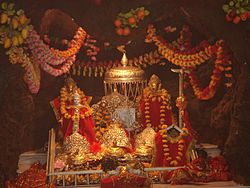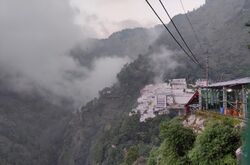Religion:Vaishno Devi
| Vaishno Devi | |
|---|---|
Mother Goddess; Goddess of hills | |
 Inside view of the Holy Cave, the 3 Pindis; Mahakali, Mahalakshmi and Mahasaraswati | |
| Other names | Vaishnavi, Mata Rani, Ambe, Trikuta, Sherawali, Jyotawali, Pahadawali, Durga, Bhagavati, Jagdamba, Lakshmi, Vishnumaya, Vishnupriya, Ramaa, Maniki |
| Affiliation | Mahadevi, Durga, Mahakali, Mahalakshmi, Mahasaraswati |
| Abode | Vaishno Devi Temple, Katra, India |
| Mount | Lion and Tiger |
| Parents | King Ratnakara |
| Consort | unmarried |
Vaishno Devi (also known as Mata Rani, Trikuta, Ambe and Vaishnavi) is a manifestation of the Hindu mother goddess Lakshmi sometimes in some beliefs Vaishno Devi is considered a manifestation of goddess Mahalakshmi. Vaishno Devi is worshipped as a combined avatar of the goddesses Mahakali, Mahalakshmi, and Mahasaraswati. Additionally, she is seen as the potency of Hari or Vishnu.
Legend

Author Abha Chauhan identifies Vaiṣṇō Dēvī with the power of Viṣṇu as well as the incarnation of Lakṣmī. Author Pintchman identifies with great goddess Mahādēvī and says Vaiṣṇō Dēvī contains all powers and is associated with the entire creation as Mahādēvī.[1] Pintchman further states that, "Pilgrims identify Vaiṣṇō Dēvī with Durgā — whom North Indians (and others) also name Sheranwali, "the Lion-rider"— more than with any other goddess".
Origin
Purana
According to Dēvī Mahābhāgavata Purāṇa, she is mentioned as "Viṣṇupriyā".[2]
In the Varāha Purāṇa's Triśakti Māhātmya, she originated from Trikalā (the goddess who was born from Trimūrtis) and slayed an asura called Mahiṣāsura on Śataśṛṅga Parvata where the current Trikūṭa Dhāma of Vaiṣṇōdēvī is situated.[3] (Disclaimer: this event is of a separate Kalpa – Mānava Kalpa – and not of our Śvēta Varāha Kalpa)
The Lakṣmīnārāyaṇa Saṃhitā's Kṛtayuga Santāna and Dvāparayuga Santāna calls her "Māṇikī", the Śakti of Kalki, as she resides on Māṇika Parvata (another name of Trikūṭa).[4]
Tantra
According to the Bṛhat Tantrasāra, she is called "Haripriyā Trikūṭā".[5]

Pilgrimage route
Pilgrims travel from the city of Jammu in Jammu and Kashmir to the village of Katra which is well connected by helicopter, rail and road. From Katra, starts the uphill journey to the Vaishno Devi Temple on foot. While on the way near the Trikuta mountain is the Banganga River. It is said that Vaishno Devi shot an arrow at the ground and brought forth the Ganga river to quench Hanuman's thirst. After Hanuman disappeared, Vaishno Devi washed her hair in the water. The Banganga river is also known as the Balganga river, since "Bal" means hair and "Ganga" is synonymous with the Holy Ganga river. Pilgrims must have a bath in the Banganga river to prove their purity. After Banganga is the Charan Paduka temple. Vaishno Devi stood on a rock to look at Bhairavnath before her escape and this rock supposedly contained her footprints. Her footprints are worshipped in this temple. After having a darshan of Charan Paduka, Pilgrims come across the Ardha Kunwari Temple. Vaishno Devi meditated in this cave for 9 months, just like how a baby stays in its mother's womb for 9 months, to escape Bhairav Nath. After having a darshan of Ardha Kunwari, the pilgrims go to the Bhairav Nath temple. It is said that after Vaishno Devi killed Bhairav Nath, Bhairav Nath realised his mistake and pleaded for forgiveness. Vaishno Devi blessed him by saying that if pilgrims did not have darshan of his head, their pilgrimage will not be fruitful. Pilgrims have a darshan of Bhairavnath's head after having Vaishno Devi's darshan at the Vaishno Devi's Temple, i.e. Bhavan. Pilgrims go inside the temple to have a darshan of the 3 pindikas (rocks) which represent Vaishno Devi.
Professor and author Manohar Sajnani says, According to Hindu beliefs, the original abode of Vaishno Devi was Ardha Kunwari, a place about halfway between Katra town and the cave. She meditated in the cave for 9 months just like how a baby stays in its mother's womb for 9 months.[6] It is said that when Bhairav Nath ran after Vaishno Devi to catch her. The Devi reached near a cave in the hill, she called up Hanuman and told him that "I would do penance in this cave for nine months, till then you should not allow Bhairav Nath to enter the cave." Hanuman obeyed the mother's orders. Bhairavnath was kept outside this cave and today this holy cave is known as 'Ardha Kunwari'.[7]
Temple

The Vaishno Devi Temple is an important Hindu temple dedicated to Vaishno Devi located in Katra at the Trikuta Mountains within the Indian Union territory of Jammu and Kashmir.[8][9][10] The temple is one of the 108 Shakti Peethas dedicated to Durga, who is worshipped as Vaishno Devi.[11] It is one of the most visited pilgrimage centers of India. Every year millions of visitors visit the temple.[12][13] During festivals like Navaratri, the count even increases to one crore visitors.[14] Vaishno Devi Temple is one of the richest temples in India. Authors Michael Barnett and Janice Gross Stein says, "Mata Vaishno Devi Shrine in Jammu has an annual income of about $16 billion, mainly from offerings by devotees".[15]
The temple is sacred to all Hindus. Many prominent saints such as Vivekananda have visited the temple.[16]
Navratri and Diwali are the two most prominent festivals celebrated in the Vaishno Devi Temple. The temple was included in the Jammu & Kashmir state government Act No. XVI/1988, and known as Shree Mata Vaishno Devi Shrine Act. The committee nominated by the state government administers the temple and has nine members on its board.
See also
- Jag Janani Maa Vaishno Devi - Kahani Mata Rani Ki
- Matrikas
- Vaishnodevi Temple, Rourkela
- Hariyali Devi / Vaishno Devi Temple located in Rudraprayag district of Uttarakhand.
- Shri Mata Vaishno Devi University
References
- ↑ Pintchman 2001, p. 62.
- ↑ "Dēvī Mahābhāgavata Purāṇa". https://archive.org/details/in.ernet.dli.2015.404138/mode/2up.
- ↑ Veda Vyasa. The Varaha Purana in English. http://archive.org/details/toaz.info-varaha-purana-unabridged-motilal-englishpdf-pr_e1d9a18739bfe3dd54249588e67c9ece.
- ↑ www.wisdomlib.org (2021-01-28). "Lakshminarayana Samhita Verse 1.334.53 [Sanskrit text"] (in en). https://www.wisdomlib.org/hinduism/book/lakshminarayana-samhita-sanskrit/d/doc531383.html.
- ↑ "Bṛhat Tantrasāra". https://archive.org/details/in.ernet.dli.2015.338822/page/n1/mode/2up.
- ↑ Manohar Sajnani (2001). Encyclopaedia of Tourism Resources in India, Volume 1. Gyan Publishing House. p. 158. ISBN 9788178350172. https://books.google.com/books?id=vdMNBxOsvrUC.
- ↑ Virodai, Yashodhara (5 October 2017). "Story of Mata Vaishnodevi" (in Hindi). Newstrend Network Communication Pvt Ltd. https://www.newstrend.news/74146/mythological-story-of-vaishno-devi-and-supernatural-power-of-temle/.
- ↑ Rindani, Kirit (2016). Indian Himalaya: Story of a 100 Visits. Partridge Publishing. p. 47. ISBN 978-1482858860. https://books.google.com/books?id=nHZ5CwAAQBAJ.
- ↑ S. S. Negi (1998). Discovering the Himalaya, Volume 1. Indus Publishing. p. 429. ISBN 9788173870798. https://books.google.com/books?id=kusLzP8H6TQC.
- ↑ Kuldip Singh Gulia (2007). Mountains of the God. Gyan Publishing House. p. 15. ISBN 9788182054202. https://books.google.com/books?id=K5AaI2PhiV8C.
- ↑ "Famous Durga temples in India for religiously inclined souls". Times of India. 5 April 2019. https://timesofindia.indiatimes.com/travel/destinations/famous-durga-temples-in-india-for-religiously-inclined-souls/as51743858.cms.
- ↑ "Vaishno Devi pilgrim footfall in 2019 lowest in 3 years: Shrine Board". Business Standard. 2 January 2020. https://www.business-standard.com/article/pti-stories/vaishno-devi-footfall-in-2019-lowest-in-3-years-shrine-board-120010200678_1.html.
- ↑ "Vaishno Devi likely to receive 8.5 mn pilgrims by Dec 31; highest in 5 yrs". Business Standard. 29 December 2018. https://www.business-standard.com/article/current-affairs/vaishno-devi-likely-to-receive-8-5-mn-pilgrims-by-dec-31-highest-in-5-yrs-118122900321_1.html.
- ↑ "Vaishno Devi-Bhairav Mandir ropeway service starts from today". The Times of India. https://timesofindia.indiatimes.com/travel/destinations/vaishno-devi-bhairav-mandir-ropeway-service-starts-from-today/as67227545.cms.
- ↑ Michael Barnett; Janice Gross Stein (3 July 2012). Sacred Aid: Faith and Humanitarianism. Oxford University Press. p. 140. ISBN 978-0199916030. https://books.google.com/books?id=L3NpAgAAQBAJ.
- ↑ Dipankar Banerjee; D. Suba Chandran (2005). Jammu and Kashmir: Charting a Future. Saṁskṛiti. p. 61. ISBN 9788187374442. https://books.google.com/books?id=iEhuAAAAMAAJ.
https://www.maavaishnavi.com/51-shakti-peethas-of-maa-durga-maa-sati-dakshayani/
External links
| Wikivoyage has a travel guide for Vaishno Devi. |
 |
